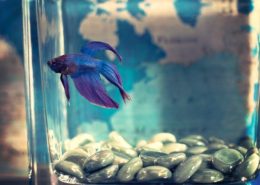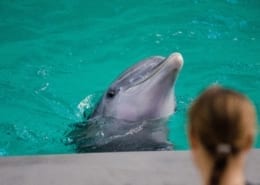Aquariums take many forms. They can range from a small tank with a few fish to a huge aquarium filled with an abundance of different fish and plant life. However, in order to have happy fish, you need a happy tank! This course is ideal for aquarium or pet shop owners or workers, those who work in related industries like tourism or conservation, or those who simply see an aquarium as a must-have home furnishing!
The Certificate of Aquarium Management is an online professional development program that will teach you about the different factors that can positively or negatively affect the dynamics of an aquarium ecosystem.
In this Aquarium Management course, you will study the scope and nature of aquaria, the water ecosystem, equipment and system design, and the range of animals and plants suitable for specific aquariums.
You will also learn about fish health and diseases, the differences between fresh and saltwater tanks and how to maintain them, and how to breed a range of fish successfully.
On completion of this course, you will be able to care for a variety of aquariums’ living inhabitants, systems and equipment to create a thriving fish-friendly ecosystem.
Course Structure
Unit - Aquarium Management
Unit 1 – Scope and nature of aquaria
- Aquarium use and management
- The categories of aquariums
- Aquariums for fish communities
- Aquaria size and complexity
- Water quality control
- Types of equipment
Unit 2 – The water ecosystem
- Interactions between organisms and the water environment
- Checking abiotic factors
- Different types of natural ecosystems
- Saltwater ecosystems
- Freshwater ecosystems
- Brackish water ecosystems
- City or municipal domestic water supplies
- Rainwater
- Well or bore water
- Water quality in the aquarium ecosystem
- Water treatment options
- Energy relationships
- Plants and nutrients
- Photosynthesis
- Pollution in an aquarium
- Nitrogen cycle
- Overcrowding
- Overfeeding
Unit 3 – Water Quality and Management
- Tank capacity/tank size
- Maintaining a balanced nitrogen cycle
- Aquarium cycling
- Changing the water
- Vacuuming
- Algae removal
- How to avoid overfeeding
- Water conditions
- Water temperature
- Water hardness
- Water PH
- Salinity
- Gas exchange in the aquarium
- Preventative care
- Moving your aquarium safely
Unit 4 – Equipment and system design
- Learn about the equipment and systems for different aquariums
- Aquarium equipment
- Aquarium tank
- Filtration
- Aeration
- Light system
- Aquarium light timer (optional)
- Tank cover
- Heaters and thermometers
- Gravel
- Plants and decorations
- Ph meters
- Refractometers/hydrometers
- Water and other additives
- Adding the fish
Unit 5 – Suitable inhabitants for your aquarium
- Determine appropriate species of animal and plant life to introduce into an aquarium.
- Freshwater fish types
- Livebearers
- Loaches
- Anabantids
- Catfish
- Tetras
- Cyprinids
- Rainbow fish
- Branchiopoda
- Gastropods
- Freshwater aquarium plants
- Cold water plants
- Tropical fresh water plants
- Brackish water plants
- Saltwater fish types
- Saltwater (marine) aquarium plants
Unit 6 – Fish health and diseases
- Fish diet
- Fish diet related problems
- Vitamin and mineral deficiency
- Origin of diseases
- Environmental diseases
- Common signs of an unhealthy tank
- Diseases caused by water quality and chemistry problems
- Water contamination and poisoning
- Ammonia and nitrate poisoning
- Oxygen starvation – hypoxia
- Pathogenic disease causes
- Viral diseases
- Bacterial diseases
- Fungal diseases
- Genetic diseases and disorders
- Parasites
- Plant problems
- Treatment of diseases and parasites
- Quarantine tank
- Coral bleaching
Unit 7 – Freshwater tanks
- How to establish a freshwater tank
- Tank selection and decorations
- Setting up tank décor
- Setting up planted tanks
- Aqua-scaping
- Basic equipment
- Electricity and aquarium set-up
- Heater installation
- Filters and air pumps
- Lighting and hood
- Solar heating
- Other equipment
- Selection and addition of fish
- Feeding requirements
- Cleaning and maintenance
Unit 8 – Simple Saltwater Tanks
- How to establish a saltwater tank
- Tank selection
- Saltwater tank cycling
- Filter
- Basic equipment for saltwater tanks
- Heaters and thermometres
- Light system
- Test kits
- Selection and addition of fish and other invertebrates
- Feeding requirements
- Cleaning and maintenance
- Critical parameters affecting salinity
- How concentrations of ions affect salinity
- How temperature affects salinity
Unit 9 – Maintenance
- Learn how to maintain a tank
- Correct tank set-up and maintenance
- Checking the lighting
- Checking the temperature
- Filter maintenance
- Checking and maintaining water quality
- Fish observation
- Plant maintenance
- Algae removal
- Regular vacuuming
- Regular water changes
- Preventative care
- Emergencies
Unit 10 – Breeding
- Fish reproduction and behaviour
- Live bearers
- Egg layers
- Breeding
- Tank set-up and general requirements
- Early stages – selecting and conditioning the pair
- Triggering breeding
- Hatching the raising fry
- Breeding and genetics
- Nutrition
- Cultivating your own food
- Fish legality in different countries
- Aquarium care
- Ultraviolet (uv) sterilisation
- Cleaning and maintenance
- Maintenance of plants
- Checking filters
- Water changes
Study Hours
Estimated duration 50 hours
Course Delivery and Start
Start anytime, self-paced and 100% online
Assessment
Assessment will be comprised of written exercises, including short-answer questions, reflective tasks, short reports and/or projects. There are no examinations or due dates for assessment. As a result, you can complete training in your own time and at your own pace with the assistance of unlimited tutor support.
Testimonials
Was very time manageable with my full time job and all questions were easy enough to read and understand. I could ask for help whenever I needed and I loved doing every moment of it.
J.Hocking, Clermont, QLD | Certificate of Aquarium Management
The website was easy to navigate, the tutor/support staff where very helpful and were able to help answer any questions I had.
L. Wykes, Kelso, TAS | Certificate of Aquarium Management
Very straightforward, enjoyable and interesting
C. Waidelich, Kiels Mountain, QLD | Certificate of Aquarium Management
It was a great experience! Great content and I never felt pressured when working on assignments
L. Higgins, Frenchs Forest, NSW | Certificate of Aquarium Management
Graduation
A Certificate of Attainment and Statement of Results will be issued upon successful completion of this course.
How to Enrol
Enrol Online: Click Enrol Now (Credit Card) or Enrol Now (Internet Banking/BPAY)
Enrol via Live Chat (Business Hours)
Enrol via Telephone 1300 76 2221 (Business Hours)
Enrol via Purchase Order/Tax Invoice
Enrolling Multiple Staff?
To enrol multiple staff, please complete the Employer Enrolment Form. We’ll be in touch within 60 minutes during business hours!
Payment Options
Visa, Mastercard, BPAY and Direct Deposit.
Course FAQs
Why Choose Australian Online Courses?
- Professional development that is widely recognised and respected;
- Improve your employment opportunities;
- Study online, anywhere via our elearning system;
- High-quality professional development programs written by industry experts;
- All course materials provided online – no textbooks to buy;
- Unlimited tutor support via email;
- We offer twelve (12) months’ access, with extensions available upon application (fees apply);
- Course may be tax deductible; see your tax advisor.
Are there any entry requirements or pre-requisites?
To study online with Australian Online Courses you will need a computer (desktop PC/laptop) running a current/updated operating system with reliable high-speed internet access. You will need to use the Google Chrome browser to access your course.
Are there any computer requirements?
To study online with Australian Online Courses you will need a computer (desktop PC/laptop) running a current/updated operating system with reliable high-speed internet access. You will need to use the Google Chrome browser to access your course.
When can I start this course?
You can start within 60 minutes during business hours when you enrol and pay in full with a credit card!
Credit card: Within 60 mins during business hours.
BPAY: Within 1-2 working days.
Internet Banking: Within 1-2 working days.
Cheque/Money Order: Upon receipt of mailed cheque.
How is this course delivered?
This course is delivered online via our easy-to-navigate Learning Management System (LMS), where you will discover interactive online learning/written content, resources and assessment.
Do I need to attend classes or undertake any work placements?
No. All courses are delivered online via our LMS and there are no work placement requirements in this course.
What support can I expect from Australian Online Courses?
Unlimited tutor support is available throughout your studies via email only during business hours Monday to Friday. Our Administrative team are available Monday to Friday via email, live chat and telephone.
I am an international student. Can I enrol into this course?
Yes! We accept enrolments from individuals both within Australia and internationally; location is no barrier to entry into our programs.
Career Pathways
Future growth
Strong
Unemployment
Low
Professional Development for:-
- Aquarium Workers
- Aquarium Owners
- Pet Shop Owners










